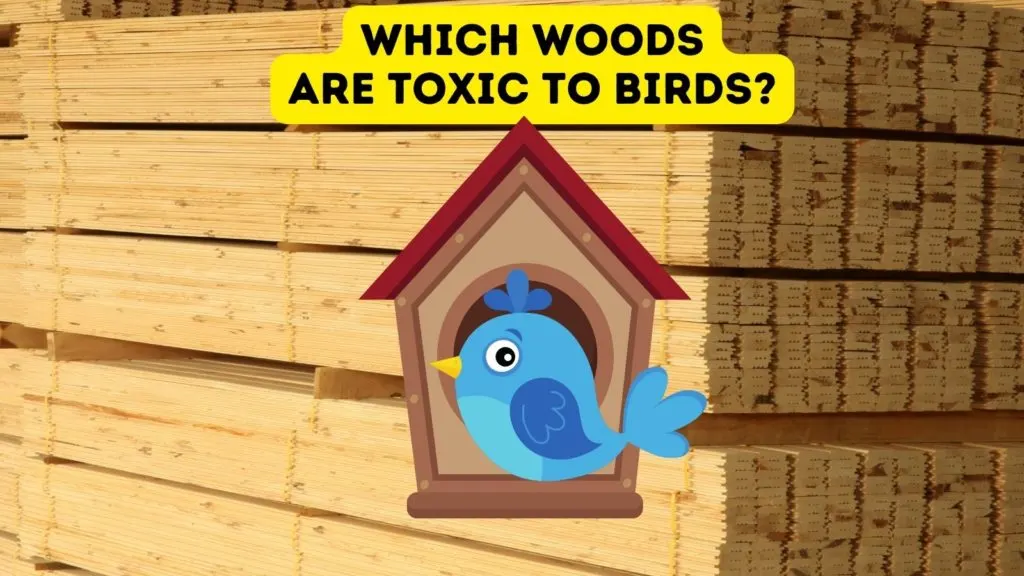Are you looking around your house for items to repurpose as a bird feeder? Or perhaps you are considering building your own bird houses? Take a moment to consider which woods are toxic to birds — including some that might surprise you!

Toxic Woods to Avoid in Bird Houses and Bird Feeders
Treated Wood
Treated wood can potentially be toxic to birds if used in bird feeders or bird houses. While it might seem like a good choice since it is made to be used outdoors, the chemicals used for the treatments are potentially hazardous!
Most wood used for outdoor construction is treated with chemicals to protect it from rot, insects, and fungi. Common treatments include copper-based preservatives and pentachlorophenol (PCP).
These chemical treatments can leach out of the wood over time, especially with weathering and exposure to moisture. Birds may ingest toxins by preening their feathers after contact with treated wood.
The chemicals in treated wood have been linked to negative health effects in birds like damage to the liver, kidneys, immune system and reproductive organs. PCP in particular is highly toxic.
The newer alkaline copper quaternary (ACQ) treated wood is less toxic than older formulations, but still not recommended for bird habitats.
Untreated or naturally rot-resistant woods like cedar, redwood and cypress are safer alternatives for birdhouses and feeders that will contact birds.
If treated wood must be used, allow it to fully cure and weather before installing to reduce leaching of chemicals.
Plywood and Particle Board
Plywood and particle board contain glues and other chemicals that can be toxic to birds. The adhesives used in these products can release formaldehyde, which is harmful when inhaled or ingested.
Some plywood and particle board is treated with flame retardants or other chemicals that could pose a risk if ingested during preening.
These woods are also not a good choice because of durability; they are not as water resistant as solid wood and can deteriorate more quickly from weather exposure.
Painted or Stained Wood
Any wood that has been painted, stained, or finished with a product not labeled as “non-toxic” or “safe for animals” should be avoided. Paints and stains can chip or flake off, and birds might ingest these particles.
Also, for as cute as painted bird houses may look, they don’t look natural–and a natural look is what’s going to attract birds to use the bird house you put out!
Safest Woods for Bird Feeders and Houses
Cedar – Most types of cedar contain natural oils that repel insects but are not toxic to birds. Western red cedar is a particularly good choice.
Redwood – Like cedar, redwood contains beneficial oils and is very rot-resistant without chemicals. It’s one of the best woods for bird structures.
Cypress – This softwood is naturally durable and low in toxins. It weathers well outdoors.
Poplar – A hardwood that is not treated or finished. It’s affordable, lightweight and stable.
Pine – Untreated pine is non-toxic. Make sure it’s dry and finished to prevent sap/resin issues.
Aspen – A softwood without toxic resins or oils. It’s lightweight for feeders.
Maple – Hardwoods like maple don’t need chemical treatments. Make sure it’s dry.
Oak – Hard and stable, oak is safe if left untreated. Avoid pressure-treated varieties.
Bamboo – Hollow bamboo poles make great feeders. Choose untreated poles.
So whether you’re looking through the garage for trays to use as bird feeders or headed to the lumber yard to purchase wood to build at bird feeder or a bird house, always use untreated, natural, and non-toxic woods.
- 8 Letter Bird Names - August 14, 2024
- 7 Letter Bird Names - August 14, 2024
- 7 Birds Named After Famous People - July 23, 2024
